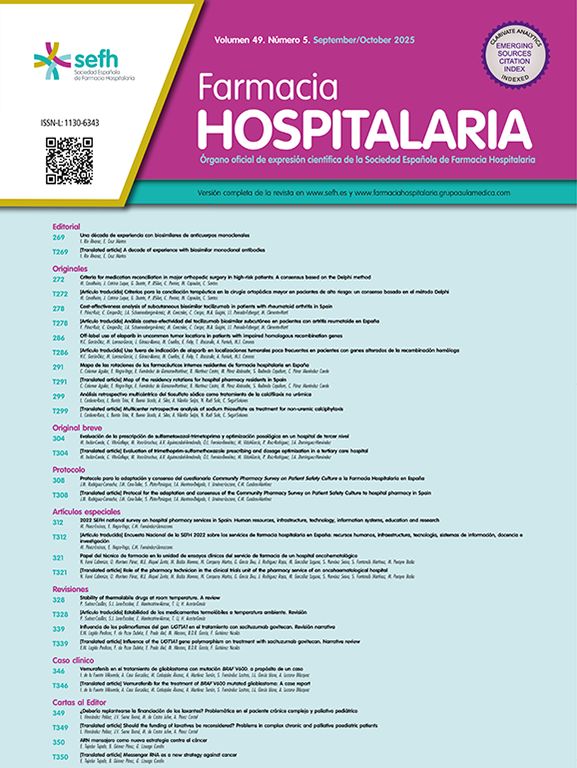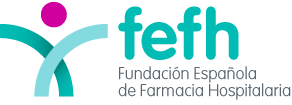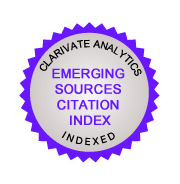Analyse the profile of parenteral preparation and treatment (anti-neoplastic and supplementary) that were dispensed and returned to the Pharmacy Department, the reasons why they were not administered, their reuse and the associated direct costs.
MethodLongitudinal study over 8 months (October 2004-May 2005) in a tertiary hospital with centre for preparing anti-neoplastic agents (including supplementary treatment) in its Pharmacy Department. The variables studied, downloaded from the Oncofarm® application, are as follows: a) patients and diagnostics; b) returned treatments, classified by reason returned, pharmaco-therapeutic scheme, cycle, and day; c) returned preparations (anti-neoplastic and supplementary) that were reused; and d) direct costs.
Data is presented with its absolute and relative frequencies and confidence intervals of 95% normalised at 1000 patients/day.
ResultsEighty-four treatments were returned by 66 patients for a total of 139 preparations corresponding to 3429 patients/day. This figure represents 24.5 (95% CI, 19.6-30.2) treatments that were prepared and not administered per 1000 patients/day, mainly due to clinical causes (n=47). Colon neoplasia and treatment with 5-fluorouracil and levofolinic acid presented the highest number of returns. The returned preparations made up 1.45% (95% CI, 1.2-1.7) of those produced. The percentage of reuse is 98%, which results in savings of €10 432.55 (90% of the cost of the treatments that are returned).
ConclusionsThe application of quality, effectiveness, and safety criteria to anti-neoplastic treatments that are prepared and returned to the Pharmacy Department allows a more efficient preparation process.
Analizar el perfil de tratamientos y preparaciones parenterales (antineoplásicas y de soporte) dispensados y devueltos al servicio de farmacia, las causas de no administración, su reutilización y los costes directos asociados.
MétodoEstudio longitudinal, prospectivo, durante 8 meses (octubre 2004-mayo 2005) en un hospital terciario con centralización de la preparación de esquemas antineoplásicos (incluye tratamiento de soporte) en el servicio de farmacia. Las variables estudiadas, descargadas del aplicativo Oncofarm®, fueron: a) pacientes y diagnósticos; b) tratamientos devueltos, diferenciando por causa, esquema farmacoterapéutico, ciclo y día; c) preparaciones devueltas (antineoplásicos y soporte) y reutilizadas, y d) costes directos. Los datos se presentan con sus frecuencias absolutas, relativas e intervalos de confianza (IC) del 95 %, normalizado a 1.000 pacientes/día.
Resultados84 tratamientos devueltos de 66 pacientes con un total de 139 preparaciones correspondientes a 3.429 pacientes/día. Este dato representa 24,5 (IC del 95 %, 19,6 a 30,2) de tratamientos preparados y no administrados por 1.000 pacientes/día, debido, mayoritariamente, a causas clínicas (n = 47).
La neoplasia de colon y el esquema de 5-fluorouracilo y ácido levofolínico presentan el mayor número de devoluciones. Las preparaciones devueltas suponen el 1,45% (IC del 95%, 1,2 a 1,7) de las elaboradas. El porcentaje de reutilización es del 98 %, con un coste ahorrado que asciende a 10.432,55 € (90 % del coste de los tratamientos devueltos).
ConclusionesLa aplicación de criterios de calidad, eficacia y seguridad a los tratamientos antineoplásicos preparados y devueltos al servicio de farmacia permite incrementar la eficiencia en el proceso de preparación.
This project has been presented partially as a poster at the 50th National Conference of the Spanish Society of Hospital Pharmacy held in Oviedo on September 27–30, 2005.





